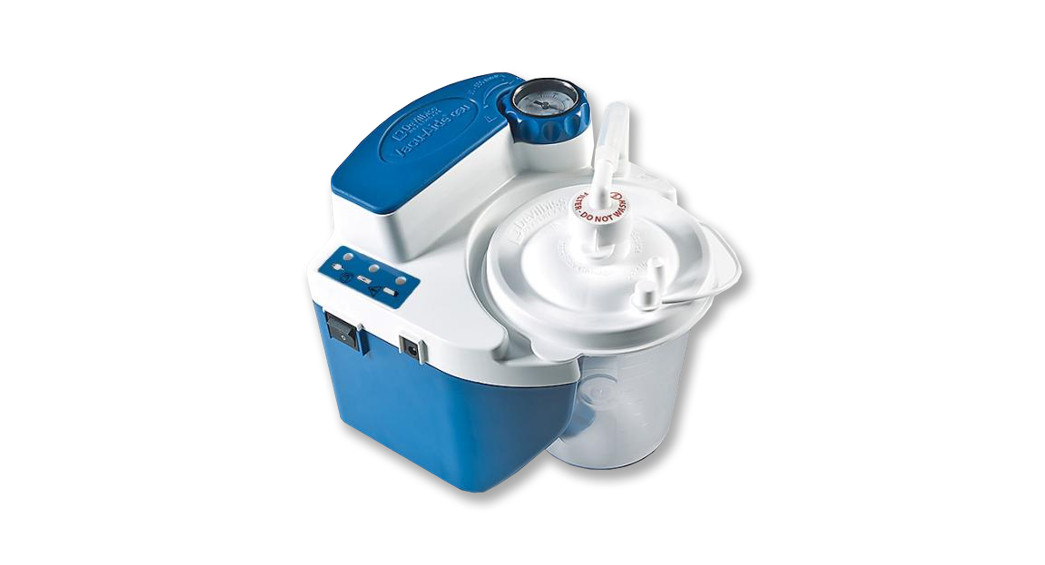


![]()
![]()
CAUTION–USA Federal law restricts this device to sale by, or on the order of a physician. Made in U.S.A.
SYMbOL DEFINITIONS
| Attention, consult instruction guide |   |
“On” compressor | |
  |
Consult instructions for use |   |
“Off” compressor (external battery charging) |
  |
Date of manufacture | External power | |
| Direct current |   |
Battery charging | |
| • |
Alternating current | ‘ |
Low battery |
| Center positive polarity indicator | . – |
Protected against solid foreign objects of 50 mm AND vertically falling water drops when enclosure is tilted up to 15° | |
  |
Type BF equipment-applied part |   |
This device contains electrical and/or electronic equipment that must be recycled per EC Directive 2002/96/EC-Waste Electrical & Electronic Equipment |
IMPORTANT SAFEGUARDS
When using electrical products, especially when children are present, basic safety precautions should always be followed. Read all instructions before using. Importantinformation is highlighted by these terms:DANGER– Urgent safety information for hazards that will cause serious injury or death.WARNING– Important safety information for hazards that might cause serious injury.CAUTION– Information for preventing damage to the product.NOTE– Information to which you should pay special attention.
READ ALL INSTRUCTIONS bEFORE USING THIS DEVICE. SAVE THESE INSTRUCTIONS.DANGERTo reduce the risk of electrocution:1. Do not use while bathing.2. Do not place or store product where it can fall or be pulled into a tub or sink.3. Do not place in or drop into water or other liquid.4. Do not reach for a product that has fallen into the water. Unplug immediately.WARNINGTo reduce the risk of burns, electrocution, fire, or injury to persons:
- Close supervision is necessary when this product is used by, on, or near children or physically incapacitated individuals.
- Use this product only for its intended use as described in this guide.
- Keep the power cord away from heated surfaces.
- Never use while drowsy or asleep.
- Do not cover the unit or the AC to DC adapter while power is applied.
- Never operate this product a.It has a damaged power cord or plug.b.It is not working properly.c.It has been dropped or damaged.d.It has been dropped into water.Instead, return the product to an authorized DeVilbiss Healthcare service center for examination and repair.
DANGERThe DeVilbiss Suction Unit is a vacuum suction device designed for the collection of nonflammable fluid materials in medical applications only. Improper use during medical applications can cause injury or death. For all medical applications:
- All suctioning should be done in strict accordance with appropriate procedures that have been established by a licensed medical authority.
- Some attachments or accessories may not fit the tubing supplied. All attachments or accessories should be checked prior to use to assure proper fit.
INTERNATIONAL TRAVEL
The 7314 series is equipped with an AC to DC adapter allowing operation on any AC voltage (100-240 VAC, 50/60 Hz). However, the correct power cord must be used toconnect to adaptable wall power.NOTE– Check the power cord for adaptability before using it.
INTRODUCTION
Your DeVilbiss Suction Unit is a compact medical suctioning device that has been designed for reliable, portable operation. Following the recommended operating andmaintenance procedures outlined in this instruction guide will maximize the life of this product.Intended Use StatementThe device is to be used to remove fluids from the airway or respiratory support system and infectious materials from wounds. The device creates a negative pressure (vacuum) that draws fluids through disposable tubing that is connected to a collection container. The fluids are trapped in the collection container for proper disposal. It is for use on the order of a physician only.
IMPORTANT PARTS OF YOUR 7314 SERIES DEVILbISS SUCTION UNIT
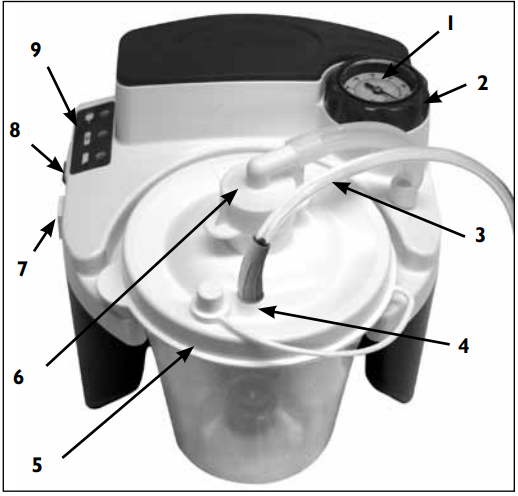

- Vacuum gauge
- Vacuum regulator knob
- 6’ patient tubing
- Tubing connector
- 800 ml disposable container with lid (float shut off incorporated into lid) and filter cartridge
- Filter cartridge with 43/8” tubing
- DC power input (on side)
- Power switch
- LED power lightsAC to DC adapter (not shown)DC power cord (not shown)Internal rechargeable battery (not shown)Carrying case (not shown)
ACCESSORY/REPLACEMENT ITEMS
The following items can be purchased separately as accessories or replacement items for your 7314 Series DeVilbiss Suction Unit:
| Description | Part No. | Description | Part No. |
| 6′ patient tubing | 6305D-611 | Power cord for the US | DV51D-606 |
| 12V DC power cord (1 each) | 7304D-619 | Power cord for Continental Europe | DV51D-607 |
| 800 ml disposable container with filter cartridge and 4W tubing (48 each) | 7305D-632 | Power cord for the UK | DV51 D-608 |
| AC to DC adapter/charger (see Specifications for manufacturer information) | 7314P-613 | Power cord for Australia | DV51D-609 |
| Carrying case | 7314D-606 | Power cord for Japan | DV51D-613 |
| Filter cartridge (12 pack) | 7305D-635 | Power cord package (Europe, UK, Australia cords) | DV51D-611 |
| Collection Container Kit (Filter cartridge, 800 ml container, 4W, and 6′ tubing package) | 7305D-633 |
NOTE– The use of electrical cables and accessories other than those specified in this manual or referenced documents may result in increased electromagnetic emissions from the product or decreased electromagnetic immunity of the product.
SET-UP & OPERATION
  |
Fully charge the battery for 10-17 hOURS. |
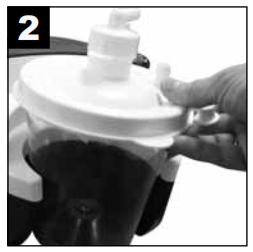  |
Insert container into the holder. |
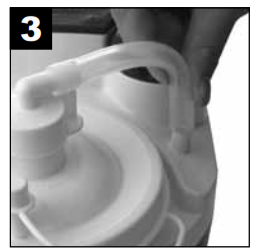  |
Attach 43/8” tubing from filter cartridge to tubing connector. |
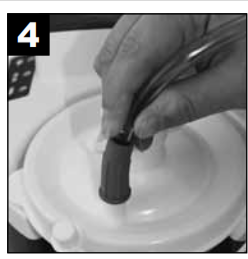  |
Attach 6’ patient tubing to container lid at outlet labeled <Patient>. |
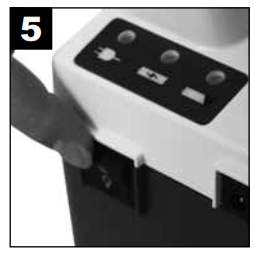  |
Ensure the power switch is “off”. |
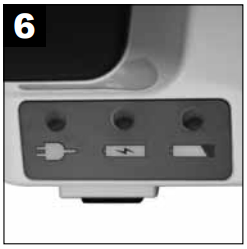  |
Select desired power source. (Skip steps 7-8 if using internal battery power.) |
  |
If using AC or DC power, plug the small connector into the DC power input on the side of the unit. |
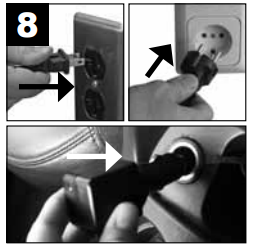  |
Plug the other end into an AC wall outlet or DC receptacle.NOTE– The AC adapter may become warm to the touch during charging or running ofthe unit. This is normal. |
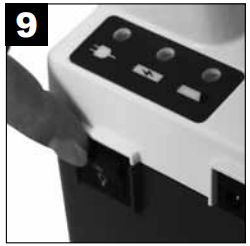  |
Turn the unit “on”. |
  |
Adjust the suction level. |
  |
Verify suction level.NOTE – Always verify suction level before beginning by occluding the open end of patient tubing while observing the gauge. Adjust knob to the desired level. |
NOTE–Inspect suction tubing and container for leaks, cracks, etc., and assure that all connections are secure and without leaks before using.
WARNINGIf the unit is not receiving power from an external source or the battery was not recharged, the low battery indicator light will remain on and the performance of the unit will drop off rapidly. Switch to another power source immediately after the low battery light appears to avoid an interrupted suction procedure.NOTE– Gauge is for reference only. If the unit sustains a severe drop, the accuracy of the gauge must be checked.CAUTION– When automatic float shut-off is activated, the contents of the collection container should be emptied. Further suctioning could cause damage to the vacuum pump.CAUTION– Should fluid be aspirated back into the unit, equipment provider servicing is necessary as possible vacuum pump damage may result.
BATTERY CHARGING & FILTER MAINTENANCE
Battery Charging
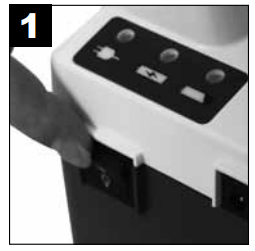   |
Ensure the power switch is “off”. |
  |
Plug the small connector of the AC or DC adapter into the DC power input. |
  |
Plug the other end into an AC wall outlet or DC receptacle. |
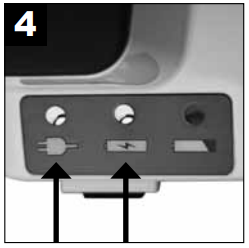  |
Battery charging begins; 10-17 hours for full charge. |
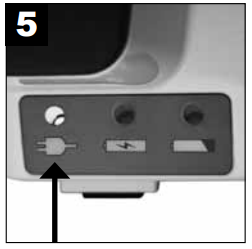  |
Battery charging complete. |
NOTE– A discharged battery will require 10-17 hours (depending on the depth of discharge) of charging to reach full capacity.NOTE– Do not connect the AC adapter to an outlet controlled by a switch to ensure power is supplied to the unit at all times.NOTE– Do not connect the DC power cord to an outlet that is not constantly energized.NOTE– A fully charged battery will provide approximately 60 minutes of continuous operation at a zero vacuum level (free flow). Operation time will decrease with higher vacuum levels.NOTE– If the unit is not in use for extended periods, the battery should be recharged every 3 months minimum.CAUTION– Discharging the battery completely will shorten its life of the battery. Do not operate the unit for more than a few minutes if the low battery indicator light is lit.Recharge as soon as possible.NOTE– When charging the battery, use an external power source and verify that the charge light illuminates when the unit is in the “Off’ position. If the battery does not charge, please contact your authorized DeVilbiss Healthcare provider.NOTE– The internal rechargeable battery is sealed lead-acid. Contact your local authorities for instruction on proper disposal.Filter Cartridge Changing
   |
Turn unit “off”. |
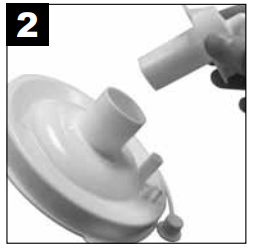  |
Remove filter cartridge and 43/8” tubing. |
  |
Install new cartridge and attach the tubing. |
CLEANING INSTRUCTIONS
Collection Container
  |
Turn the unit “off” and allow the vacuum to drop. |
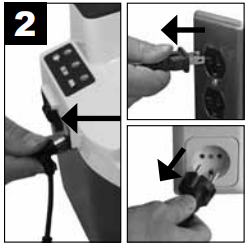  |
Disconnect from the power source |
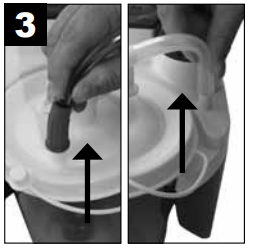  |
Disconnect tubing and remove the container from the holder. |
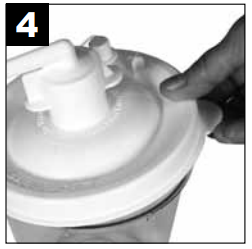  |
Carefully remove the lid and empty contents.NOTE– The 800ml disposable collection container and lid are meant for single-patient use. |
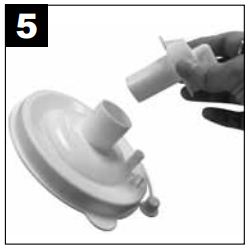  |
Remove filter cartridge and 43/8” tubing and set aside. |
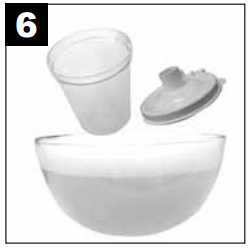  |
Wash container and lid in warm water/dishwashing solution. Rinse with clean, warm water.NOTE– If desired, the float ball can be removed for washing by pushing the ball out of the lid assembly. |
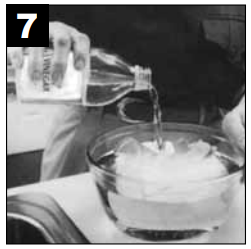  |
Wash in 1 part vinegar to 3 parts warm water solution.Rinse with clean, warm water, and air dry. |
6’ Patient Tubing
  |
Disconnect from the lid. |
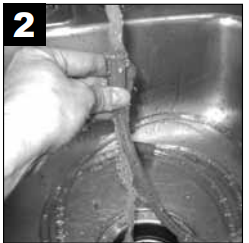  |
Rinse thoroughly by running warm tap water through it. |
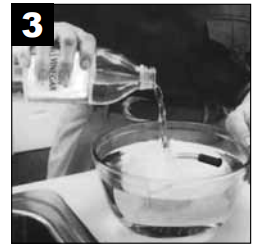  |
Follow by running a solution of 1 part vinegar to 3 parts warm water through it. Rinse with warm tap water and air dry. |
  |
Keep outer surface clean by wiping with a clean, damp cloth |
Suction Unit
  |
Turn unit “off” and allow the vacuum to drop. |
  |
Disconnect from the power source. |
  |
Wipe the housing with a clean cloth and any commercial (bacterial-germicidal)disinfectant. |
AC to DC Adapter
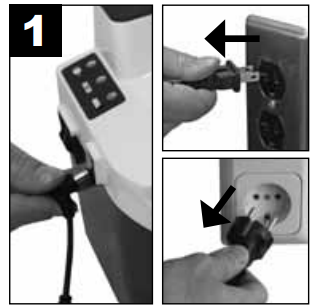  |
Disconnect AC to DC adapter from the unit and from the power source. |
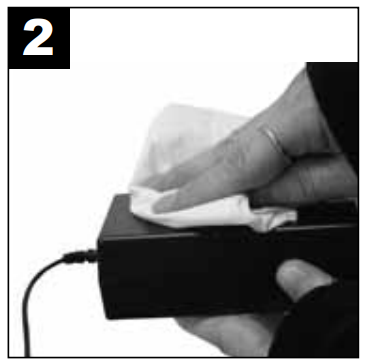  |
Wipe AC to DC adapter housing and cords with a dry cloth. |
Carrying Case
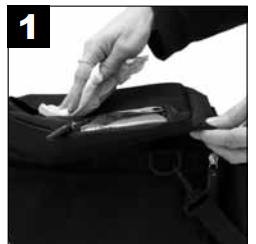  |
Wipe with a clean cloth dampened with detergent or disinfectant. |
TROUbLESHOOTING
NOTE– Your DeVilbiss Suction Unit contains no user-serviceable parts. If you believe your unit is not working properly, BEFORE YOU RETURN IT TO YOUR DEVIlBISS HEAlTHCARE PROVIDER WHERE YOU PURCHASED IT, PlEASE TAkE A FEW mOmENTS TO CHECk FOR THESE POSSIBlE CAUSES:
| PROBLEM | ACTION |
| The unit does not turn on (no external power is connected). | 1. Check that battery is fully charged and/or charge battery. |
| The unit does not turn on when external power is connected. Green external power light does not illuminate. | 1. Check power sources and connections.2. Ensure the wall outlet is live by plugging in a lamp. |
| Pump runs, but there is no suction. | 1. Check that all tubing is connected properly.2. Check tubing connections for breaks or leaks.3. Ensure that float shut-off in the collection container is not activated or the filter cartridge occluded.4. Check for leaks or cracks in the collection container assembly. |
| Low suction. | 1. Use a vacuum regulator knob to increase the suction level.2. Check the system for leaks. |
| The battery will not charge (external power and charge indicator lights should be illuminated during charge mode) | 1. Verify that both external power and charge indicator lights illuminate.2. Check power sources and connections.3Ensure the wall outlet is live by plugging in a lamp. |
SPECIFICATIONS/CLASSIFICATIONS
| Size (including container) | 8.3 H x 8.0 W x 8.5 0 (21.1 cm x 20.3 cm x 21.6 cm) (not including AC to DC adapter) |
| Weight (including container) | 6.6 lb. (3 kg) (not including AC to DC adapter) |
| Typical Operating Sound Level | 55 dBA |
| Electrical Requirements | 100-240V–, 50/60Hz, 1.2A max –0—.; 12V ., 33 W Max |
| Vacuum Range | 50-550 mm Hg +1- 10%* |
| Air Flow @ Pump Inlet: | 27 LPM (free flow) typical (maybe less when running from the internal battery)’ |
| Collection Container Capacity | 800 ml (cc) Disposable |
| Warranty | Two-years limited, excluding internal battery and collection container |
| Internal Battery | 90-day |
| Approvals | IEC 60101-1-2; CSA-C22.2 # 601.1; UL 60601-1; EN 60601-1-2; ISO 10079-1; IEC 60601-1; IEC 60529 IP12; IEC 60601-1-6; CENELEC EN 60601-1 |
| Adapter Manufacturer Information | Emerson Model # AD5012N2LM or Autec Power Systems Model # DTM36-12 or SL Power/Ault Model # MENB1040Al240NO2 |
| Environmental Conditions | |
| Operating Temperature Range | 32°F (0°c) – 104°F (40°c) |
| Operating Relative Humidity | 0-95% |
| Operating Atmospheric Pressure | 10.2 psi (70 kPa) – 15.4 psi (106 kPa) |
| Storage & Transport Temperature Range | -40°F (-40°c) – 158°F (70°c) |
| Storage & Transport Relative Humidity | 0-95% |
| Storage & Transport Atmospheric Pressure | 7.3 psi (50 kPa) – 15.4 psi (106 kPa) |
| Equipment Classifications | |
| With respect to protection from electric shock | Class II and internally powered |
| Degree of protection against electric shock | Type BF Applied Parts |
| Degree of protection against ingress of liquids | IP12 and ordinary power supply |
| Mode of Operation | Intermittent Operation: 30 minutes on, 30 minutes off |
| Equipment not suitable for use in the presence of a flammable anesthetic mixture with air or with oxygen or nitrous oxide. | |
| ISO Classification | |
| Electrically powered medical suction equipment for field and transport use according to EN ISO 10079-1: 2009 | |
| High Flow/High Vacuum |
* Conditions may vary based on altitude above sea level, barometric pressure, and temperature.Manufacturer’s NoteThank you for choosing a DeVilbiss Suction Unit. We want you to be a satisfied customer. If you have any questions or comments, please send them to our address on theback cover.For Service Call Your Authorized DeVilbiss Healthcare Provider:
| Phone | Purchase Date | Serial # |
DEVILbISS GUIDANCE AND MANUFACTURER’S DECLARATION
WARNINGMedical Electrical Equipment needs special precautions regarding Electromagnetic Compatibility (EMC) and needs to be installed and put into service according to the EMC information provided in the accompanying documents.Portable and Mobile RF Communications Equipment can affect Medical Electrical Equipment.The equipment or system should not be used adjacent to or stacked with other equipment and that if adjacent or stacked use is necessary, the equipment or system should be observed to verify normal operation in the configuration in which it will be used.
NOTE– The EMC tables and other guidelines provide information to the customer or user that is essential in determining the suitability of the Equipment or System for theElectromagnetic Environment of use, and in managing the Electromagnetic Environment of use to permit the Equipment or System to perform its intended use without disturbing other Equipment and Systems or non-medical electrical equipment.
Guidance and Manufacturer’s Declaration – Emissions All Equipment and Systems
| This device is intended for use in the electromagnetic environment specified below. The customer or user of this device should assure that it is used in such an environment. | |||
| Emissions Test | Compliance | Electromagnetic Enforcement – Guidance | |
| RF Emissions CISPR 11 | Group 1 | This device uses RF energy only for its internal function. Therefore, its RF emissions are very low and are not likely to cause any interference in nearby electronic equipment. | |
| RF Emissions CISPR 11 | Class B Radiated andConducted Emissions | This device is suitable for use in all establishments including domestic, and those directly connected to the public low-voltage power supply network that supplies buildings used for domestic purposes. | |
| Harmonics IEC 61000-3-2 | Class A | ||
| Flicker IEC 61000-3-3 | Complies | ||
| Immunity Test | IEC 60601 Test Level | Compliance Level | Electromagnetic Environment – Guidance |
| Electrostatic Discharge (ESD) IEC 61000-4-2 | ±6kV contact ±8kV air | ±6kV contact ±8kV air | Floors should be wood, concrete or ceramic tile. If floors are synthetic, the relative humidity should be at least 30%. |
| Electrical Fast Transient/ burst IEC 61000-4-4 | ±2kV on AC Mains | ±2kV on AC Mains | The mains power quality should be that of a typical commercial or hospital environment. |
| SurgeIEC 61000-4-5 | ±1kV Differential ±2kV Common | ±1kV Differential ±2kV Common | The mains power quality should be that of a typical commercial or hospital environment. |
| Voltage dips, short interruptions, and voltage variations on power supply input lines IEC 61000411 | >95% Dip for 0.5 Cycle 60% Dip for 5 Cycles 30% Dip for 25 Cycles >95% Dip for 5 Seconds | >95% Dip for 0.5 Cycle 60% Dip for 5 Cycles 30% Dip for 25 Cycles >95% Dip for 5 Seconds | The mains power quality should be that of a typical commercial or hospital environment. If the user of this device requires continued operation during power mains interruptions, it is recommended that the device be powered from an uninterruptible Power supply or battery. |
| Power Frequency 50/60Hz Magnetic FieldIEC 61000-4-8 | 3A/m | 3A/m | Power frequency magnetic fields should be that of a typical location in a typical commercial or hospital environment. |
| Conducted RFIEC 61000-4-6 | 3 Vrms from150 kHz to 80 MHz | 3 Vrms | Portable and mobile RF communications equipment should be separated from the device by no less than the recommended separation distances calculated listed below:D=(1.2)iP |
| Radiated RF IEC 61000-4-3 | 3 V/m80 MHz to 2.5 GHz | 3V/m | 1/:(1.2)IP 80 to 800 MHz1/:(2.3)./P 800 MHz to 2.5 GHzWhere P is the maximum power rating in watts and D is the recommended separation distance in meters.Field strengths from fixed transmitters, as determined by an electromagnetic site survey, should be less than the compliance levels (3 Vrms and 3V/m). Interference may occur in the vicinity of equipment containing a transmitter. |
| For transmitters rated at a maximum output power not listed above, the recommended separation distance D in meters (m) can be estimated using the equation applicable to the frequency of the transmitter, where P is the maximum output power rating of the transmitter in watts (W) according to the transmitter manufacturer.Note 1: At 80 MHz and 800 MHz, the separation distance for the higher frequency range applies.Note 2: These guidelines may not apply in all situations. Electromagnetic propagation is affected by absorption and reflection from structures, objects, and people. | |||
| Maximum Output Power (Watts) | Recommended Separation Distances for the device (meters) | ||
| 150 kHz to 80 MHz D=(1.2)FP | 80 to 800MHz D=(1.2)FP | 800 MHz to 2.5 GHz Dr(2.3).ff) | |
| 0.01 | 0.12 | 0.12 | 0.23 |
| 0.1 | 0.38 | 0.38 | 0.73 |
| 1 | 1. | 1. | 2. |
| 10 | 4. | 4. | 7. |
| 100 | 12 | 12 | 23 |
| For transmitters rated at a maximum output power not listed above, the recommended separation distance D in meters (m) can be estimated using the equation applicable to the frequency of the transmitter, where P is the maximum output power rating of the transmitter in watts (W) according to the transmitter manufacturer.Note 1: At 80 MHz and 800 MHz, the separation distance for the higher frequency range applies.Note 2: These guidelines may not apply in all situations. Electromagnetic propagation is affected by absorption and reflection from structures, objects, and people. |



DeVilbiss Healthcare LLC100 DeVilbiss DriveSomerset, PA 15501-2125USA800-338-1988 • 814-443-4881
| DeVilbiss Healthcare LtdUnit 3, Bloomfield ParkBloomfield RoadTipton, West Midlands, DY4 9APUnited KinGDoM+44 (0) 121 521 3140 |
| DeVilbiss Healthcare SAS13/17, Rue Joseph Priestley37100 ToursFrance+33 (0) 2 47 42 99 42 |
| DeVilbiss Healthcare Pty. Limited15 Carrington Road, Unit 5Castle Hill nSW 2154AUSTRALiA+61-2-9899-3144 |


| DeVilbiss Healthcare LLC • 100 DeVilbiss Drive • Somerset, PA 15501 • USA800-338-1988 • 814-443-4881 • www.DeVilbissHealthcare.com |
DeVilbiss®and Vacu-Aide ®QSU are registered trademarks of DeVilbiss Healthcare.© 2012 DeVilbiss Healthcare LLC. 07.12 All Rights Reserved.
[xyz-ips snippet=”download-snippet”]

